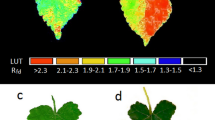Abstract
The ratio of fluorescence intensities for chlorophylla before and after acidification is dependent upon the excitation wavelength and upon the spectral band width of the exeitation beam. Optimal conditions for differentiating between chlorophylla and pheopigments occur when the excitation wavelength is in the range of 435 to 440 nm and the half-value width of the beam is less than 6 nm. The reduced sensitivity brought about by the low amount of energy reaching the sample under these conditions can be compensated for by minor modification of other instrumental parameters.
Similar content being viewed by others
Literature cited
Battin, G. A. W.: Nomograns for chlorophyll determinations. J. mar. biol. Ass. U.K.47, 407–414 (1967).
Chen, R. F.: Practical aspects of the calibration and use of the Aminco-Bowman spectrophotofluorometer. Analyt. Biochem.20, 339–357 (1967).
Holm-Hansen, O., C. J. Lorenzen, R. W. Holmes andJ. D. H. Strickland: Fluorometric determination of chlorophyll. J. Cons. perm. int. Explor. Mer30, 3–15 (1965).
Lorenzen, G. J.: Determination of chlorophyll and pheopigments: spectrophotometric equations. Limnol. Oceanogr.12, 342–346 (1967).
Moss, B.: A spectrophotometric method for the estimation of percentage degradation of chlorophylls to pheopigments. Limnol. Oceanogr.12, 335–340 (1967).
Patterson, J. andT. R. Parsons: Distribution of chlorophylla and degradation products in various marine materials. Limnol. Oceanogr.8, 355–356 (1963).
Saijo, Y. andS. Nishizawa: Excitation spectra in the fluorometric determination of chlorophylla and pheophytina. Mar. Biol.2, 135–136 (1969).
Strickland, J. D. H. andT. R. Parsons: A manual of sea water analysis (2nd rev. ed.). Bull. Fish. Res. Bd Can.125, 1–203 (1965).
White, C. E., H. Ho andE. Q. Weimer: Methods for obtaining correction factors for fluorescence spectra as determined with the Aminco-Bowman spectrophoto-fluorometer. Analyt. Chem.32, 438–439 (1960).
Yentsch, C.S.: Environmental physiology of marine plankton.In: Biochemistry and physiology of marine algae, pp 771–797. Ed. byR. A. Lewin. New York: Academic Press 1962.
— Distribution of chlorophyll and pheophytin in the open ocean. Deep Sea Res.12, 653–666 (1965).
— andD. W. Menzel: A method for the determination of phytoplankton chlorophyll and pheophytin by fluorescence. Deep Sea Res.10, 221–231 (1963).
— andJ. H. Ryther: Absorption curves of acetone extracts of deep water particulate matter. Deep Sea Res.6, 72–74 (1959).
Author information
Authors and Affiliations
Additional information
Communicated byJ. Butt, Miami, andB. Battaglia, Padua
Contribution N. 665 of the biology Division, Commission of the European Communities.
Rights and permissions
About this article
Cite this article
Baudouin, M.F., Scoppa, P. Fluorometric determination of chlorophylla in the presence of pheopigments: effect of the half-value width of the excitation beam. Mar. Biol. 10, 66–69 (1971). https://doi.org/10.1007/BF02026767
Accepted:
Issue Date:
DOI: https://doi.org/10.1007/BF02026767




